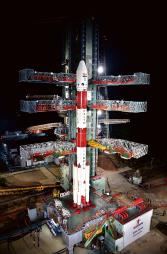On September 1st, in Sriharikota, Andhra Pradesh, something happened.
India will send a spacecraft to the Sun called Aditya L1, using ISRO’s PSLV rocket. This will happen 125 days after their recent mission to the Moon.
The countdown for the launch of Aditya L1 on PSLV C57 has started and will last for 23. 10 hours, according to ISRO.
The Sun observatory mission will be launched from the second launch pad at this spaceport at 11. 50 am on Saturday. It is happening right after India’s successful moon expedition called Chandrayaan-3 that happened last month.
The Chairman of ISRO, S Somanath, said that it will take 125 days for the Sun mission to reach the specific distance.
Aditya L1 is made to observe the sun’s corona from far away and study the solar wind at a point called L1 that is 1. 5 million kilometers away from Earth.
ISRO says there are five special points between the Sun and the Earth. The L1 point in the Halo orbit is the best place to watch the Sun without any eclipses happening.
ISRO said that this will give a better advantage of watching the solar activities all the time.
The space agency in Bengaluru said that studying the Sun is easier because it is the closest star.
The Indian Space Research Organization (ISRO) stated that by studying the Sun, we can learn more about stars in our own galaxy, the Milky Way, as well as in other galaxies.
The Sun has many explosive events and gives off a lot of energy in space. If powerful solar events are aimed at the earth, it can lead to different problems in the space near our planet.
The message from ISRO is that spacecraft and communication systems can be affected by disruptions. It is important to be alerted about these disruptions early so that actions can be taken to fix them in advance.
ISRO scientists have used a more powerful version of a rocket called PSLV to launch a spacecraft on Saturday. The rocket, called ‘XL’, will also carry seven additional items.
In 2008, a similar version of the PSLV-XL rocket was used for the Chandrayaan-1 mission. It was also used in 2013 for the Mars Orbiter Mission.
There are seven things that are being carried on the spacecraft. Four of them will look at the Sun, and the other three will study particles and fields at a specific point called L1.
At first, the Aditya-L1 spacecraft will be put into a close orbit around the Earth. The text could be simplified as: The spacecraft will be made smaller and then sent into space to go to a place called Lagrange point L1, using its own engines.
The spacecraft will leave Earth’s gravity as it travels towards L1. After leaving, the spacecraft will start the cruise phase and then be placed into a big circular orbit around L1. It would take about four months to get to the planned L1 spot.
The Aditya-L1 payloads will give us important information about coronal heating, CMEs, pre-flares, and flare activities. This information will help us understand their characteristics, dynamics, and space weather.
The main purpose of the Aditya-L1 mission is to send 1,440 pictures every day to a station on the ground for examination. These pictures will be analyzed once the mission reaches its planned orbit.
The biggest and most difficult payload on Aditya-L1, called VELC, was put together, checked, and set up for optimal performance at the Indian Institute of Astrophysics CREST (Centre for Research and Education in Science Technology) in Hoskote near Bengaluru, with significant teamwork from ISRO.
From the continuous channel, which is the channel for capturing images, an image will be received every minute. Muthu Priyal, the Project Scientist and Operation Manager for VELC, stated that we will be getting around 1,440 pictures in 24 hours at the ground station.
The propulsion systems for the mission were provided by the Thiruvananthapuram-based Liquid Propulsion System Centre (LPSC).
The Liquid Apogee Motor (LAM) created by the LPSC is very important for moving satellites/spacecraft in India’s big space accomplishments, like the three Chandrayaan expeditions or the 2013 Mars Orbiter Mission (MOM).
“Now we are also involved in the Aditya L1 Mission. The Aditya spacecraft has a special and flexible thruster called LAM, which produces a force of 440 newtons,” explained Dr AK Asraff, the deputy director of LPSC.
The goal of the Mission is to learn more about the sun’s atmosphere, how solar wind is spread out, and the differences in temperature in different directions, among other things.
The Indian Institute of Astrophysics (IIA) professor and scientist Dr R Ramesh says that it is important to continuously monitor the Sun for 24 hours in order to study solar quakes. These quakes can change the Earth’s geomagnetic fields.
He said that we should study the Sun because it has something like earthquakes called solar quakes or Coronal Mass Ejections (CME) on its surface.
In this process, a huge amount of solar materials are thrown into space, and some of these solar materials can also be directed towards the Earth.
Please rewrite the text you want me to simplify.
Moon conquered, ISRO all set for Sun mission with Aditya launch on September 2


